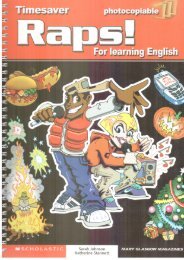English_Book_2-Teacher_300913
English_Book_2-Teacher_300913
English_Book_2-Teacher_300913
You also want an ePaper? Increase the reach of your titles
YUMPU automatically turns print PDFs into web optimized ePapers that Google loves.
4 Vocabulary (10 min.)A.• Read the instructions aloud. Then read the labelson the pictures and have students say them afteryou. Point out that either eat or have can be used totalk about meals and snacks.• As a model, call on a student to tell the classwhat he or she does first, second, and third. Thenhave students work individually to number theactivities. Number the pictures to match your ownroutine in preparation for Exercise B.B.• PAIRS. Read the instructions aloud and modelthis activity with a student. Put your book next tothe student’s book. Model talking about how yourroutines are the same and different.• Have students form pairs. Walk around to monitoras students talk.• To conclude this activity, call on severaldifferent students to tell the class ways in whichways their routine was the same or different fromtheir partner’s.Extension• Have students play a memory game in small orlarge groups. Tell them that they are to build upa string of sentences about daily routines fromthe beginning of the day to the end. Student Asays, I wake up. Student B says, I wake up. I getup. Student C says, I wake up. I get up. I take ashower. Students continue adding sentences untila student makes a mistake or can’t remembera sentence. Then the group must begin again.Model this for the class before assigning groups.Have students complete Workbook Exercises 1–3.Grammar Focusand Discovering grammar (10 min.)Sequence words☞ See Grammar reference, page 99.• Direct students’ attention to the grammar chart.Call on students to read the sequences aloud.Make sure students understand that first andfinally come at the beginning and end of thesequence, but that then, after that, and next areinterchangeable.• Read the instructions and questions aloud;explain common and punctuation if needed. Thenhave students work individually to complete theexercise. Check answers orally.Answer key1. first, then, after that, next, finally 2. , (a comma)• Use the board to elicit other key points aboutthe grammar chart, such as when to use thesimple present and which sequence words can befollowed by a comma.Practicing grammar5 Practice (5 min.)• Read the instructions and first sentence aloud. Tellstudents that they need to write any three thingsBrian does in the morning and that they need to bein order. Tell them not to look back at the reading.• When students have finished writing, let themlook back at the reading to check their answers.Ask students to raise their hands if their answerswere correct. Elicit answers from several students.Have students complete Workbook Exercises 4–8and Grammar Builder Exercises 1–2.6 Your turn (5 min.)• PAIRS. Read the instructions and example aloud.Model the activity with a student. Then assignpairs and tell students to begin.• To check, ask a few volunteers to share what theydo with the class. Ask for a show of hands of otherstudents who do the same sequence of events.7 Communication (10 min.)A.• 25 Play the audio as students read along. Checkthat students understand Nothing much, check mye-mail, text my friends, and call up. Play the audioagain, pausing for students to repeat.B.• PAIRS. Read the instructions aloud. Call on apair to model. Then have students form pairsto discuss their routines. Circulate and monitor,helping with vocabulary as needed. Check bycalling on several students to tell you what theydo on Sundays.Cross-curricular activity: science• Select a simple natural process that studentsare very familiar with, such as the life cycle of afrog, butterfly, or plant. Elicit from the class thedifferent steps in this process. Let students useL1 if needed, and help them translate the stepsinto <strong>English</strong>. Alternately, have them work ingroups with a dictionary before elicitingthe steps.• Write the steps on the board.• Have students form groups and make a posterof the process by drawing each step and labelingit, using sequence words in their sentences.Have students complete Workbook Exercises 15–17.TEACHER’S NOTEST16:27:51 PMPostcards_splitB_TE1_U02.indd T162/27/07 10:22:08 AM




